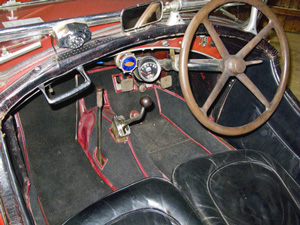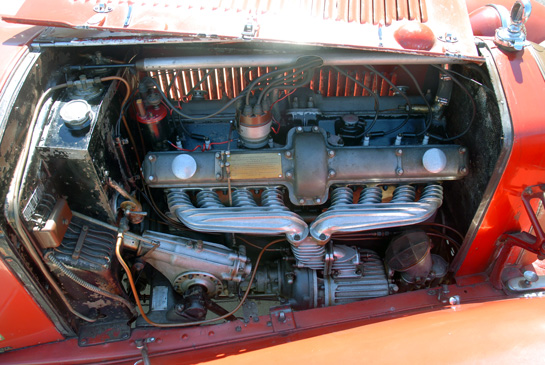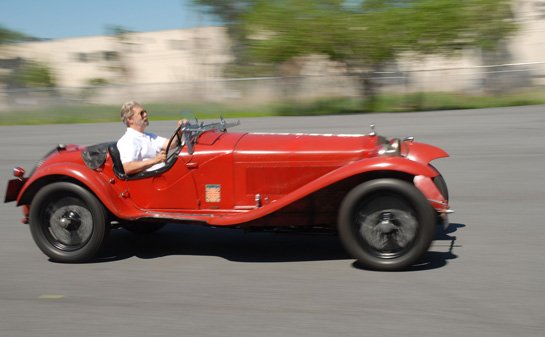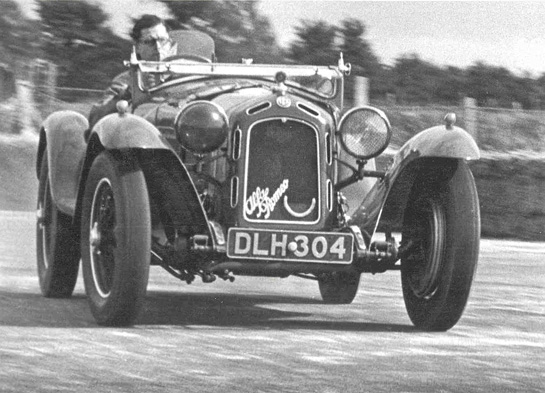 As part of the series of Demonstration Days at the Simeone Foundation VeloceToday was provided an opportunity to drive two very special Alfa Romeos, an 8C 2300 and an RLSS. A special thanks to Fred Simeone, Harry Hurst and Curator Kevin Kelly.
As part of the series of Demonstration Days at the Simeone Foundation VeloceToday was provided an opportunity to drive two very special Alfa Romeos, an 8C 2300 and an RLSS. A special thanks to Fred Simeone, Harry Hurst and Curator Kevin Kelly.
Please make note that on June 19, the Foundation will present “Alfa Romeo turns 100” and bring out eight Alfas ranging in date from 1927 to 1975, including five rare 8C models.
By Pete Vack
Color photos by Harry Hurst
Serial number 2211072, the Alfa Romeo 8C2300 MM Spyder on display at the Simeone Foundation in Philadelphia, is the only 8C 2300 Spyder to be bodied by Castagna. According to Simon Moore, it likely started life as a factory racecar before being sold to privateers. Raced in the 1935 Mille Miglia by Catullo Lami and Pasquale Ermini, (who would later build Etceterinis) it was forced to retire. Exported to the UK it led a happy and active life for many years with a number of enthusiastic owners. It has a few famous ex’s, but our favorite is Charles Addams, who is also the editor’s favorite cartoonist. (Next week we’ll tell you more about Addams and his family of cars.) Furthermore, aside from an engine rebuild in the UK, this 8C 2300 is apparently original and unrestored. All of which make this a very, very special Alfa 8C 2300. (For more details on this Alfa, see “Reflections on a Castagna Alfa”). So, without further wordiness, let’s get it on.
Just get in the car and go

The round knob next to the add-on tach is used to adjust the shock absorbers from the cockpit and is made by Siata. The center throttle pedal can be seen below the tach.
Please take the time to contribute and keep VeloceToday coming to your inbox every week. It’s easy and safe. Simply click here for details. If you are enjoying this article, why not consider a donation to VeloceToday? Click here for details..it’s easy!
________________________________________________________________
The engine barks, the noises coming from the straight eight and the exhaust dominates everything. Like other Alfa 8C’s this writer has experienced, it is a machine that generates power by the brutal and audible forces of metal on metal separated only by a light film of oil. It seems rough, but it has high lift Mille Miglia cams, and doesn’t particularly care for revs under 2500 rpm. New, the rev limit was right around 5750 rpm. There is no need to take it anywhere close to that as there is plenty of torque, aided by a drag strip final drive ration of 4.5 to 1. The center accelerator pedal has a somewhat long and loose feel, and the flywheel does not allow for instant revs. But the throttle is sensitive enough and easy to use, though placed too close to the steering column for my taste.

This particular 8C 2300 has hi lift cams, better carburetion and the supercharger was modified, all of which helped the car achieve a 0-60 time of 6.5 seconds.
The clutch has a very short throw, some what of a concern at first but when it is used to engage the mechanism, it’s very smooth a despite the short path to engagement. The multi-disc clutch is very effective, though Kevin warns us “… if you overheat the clutch, the discs will warp,” no doubt having visions of a disassembled Alfa gearbox on his bench after the guests have left. The gearshift is a willowy thing, with the chrome gate much like Ferrari of many years later. It is an H shift pattern with a reverse lockout
No problem, we can do this
Great. We have under us a right hand drive car with left hand gearlever, a central throttle pedal and mechanical brakes. No problem, we can do this. I tell Kevin how Stirling Moss hated the central throttle pedal arrangement still found on 1950 era Maseratis and had them all changed.
So what is this going to be like? All systems are go and we let out that clutch, carefully without too many revs. Thankfully it doesn’t stall and the rest is almost a piece of cake. The steering, which felt a little loose when parked, comes up fine and feels tight now, and very direct and sensitive. The big wheel helps, and though it lightens up at speed, it never becomes light; it is always a tough steer. There’s a lot of weight on the front end, and with less than three turns from lock to lock the work is in the steering.
Keeping oneself in check
Surprisingly the brakes are firm, require less pedal pressure than one might imagine, and stop the car smoothly without pulling. They must be in pretty good shape, and Kevin has not had to adjust them, yet. It is a bit tricky to remember that the brakes are where the throttle pedal should be. Coming into a corner to slow down, it’s easy to naturally go for the center pedal. And on Fred’s nice but short lot, that would be very uncool. Shifting is slow. In order not to grind the gears, those rpms have come down and the lever felt into the next gear. Downshifting is almost easier and quicker. It helps that every molecule of the car is vibrating and transmitting information to the driver, who can easily feel what needs to be done to make the car work. Usually, anyway.

Right hand drive, left hand shift, center throttle pedal all make it necessary to concentrate full time on the driving chores. But what a wonderful drive!
Well, this wasn’t so bad now was it….but the engine was still barking and it felt rough. After a bit I dared looked down to find the tach and realized that we were still doddering around under 2500 rpm in second and third with corners coming up far too quickly. Hmm. Wonder what 4000 rpm in fourth might be like…might be fun with the heavy steering and rod operated brakes. All of this took some getting used to, and as I circulated, the brakes got warmer and better, and everything seemed to come together but I was still hesitant to use more revs. It was getting more like fun with every go around. You know the feeling, after a bit you just don’t want to come in.
Yes, it’s FAST
But eventually, reluctantly, I did, pulling up to a stop near the waiting and watching but still smiling Curator. “Still seems rough” I yelled. Kevin, eager to join in the fun, asked me to move over and jumped in. He immediately got the old Alfa into third gear and started to build up some steam. “It’s got to run over 3000 rpm,” he hollered over the noise of the engine, which was just now sounding more efficient. And indeed, the engine sang a better song at around 3500 rpm. We were really moving now, and I braced for the turns—the grab handle is there for a reason. Kevin was going around much faster than I dared and hardly letting off. He was enjoying himself, and I was amazed at the car’s ability to corner rapidly without so much as a tire squeal. We both grinned madly as Kevin, too, just didn’t want to come in.
Fast. In its day, this Alfa was a 135 mph car; it may well be a 135 mph car today as well. In 1939, in the hands of Guy Templer, the car was officially timed at 116 mph on the outer circuit and 135 mph on the Railway straight. Amazingly, zero to sixty was obtained in 6.5 seconds. It also participated in the “Fastest Road Car at Brooklands”. After the war, at Brighton, it was timed as the fastest sports car, in 1947 it was first in class at Merston and second fastest sports car at Prescott. It was also, by the written accounts of the owners over its 78 year old history, extremely reliable, in daily use for the better part of the twentieth century.

Guy Templer driving the 8C in the UK during the late 1930s. Templer drove it in a many club events including the “Fastest Road Car at Brooklands” in 1939. Here he is seen with a bit of opposite lock.
Our drive was but just a taste of the magic of the 8C Alfas, but one which, like the memory of the fragrance of burning castor oil, will linger forever.
Next up, the RLSS built for Michael Rennie’s father.
Simeone Foundation Automotive Museum
6825-31 Norwitch Drive
Philadelphia PA 19153
(215) 365-SAFE (7233)
Fax: (215) 365-8230
The Simeone Foundation Museum is conveniently located just minutes off Interstate 95 in Philadelphia, close to Center City and the Philadelphia International Airport.
Museum Hours
Tues 10AM – 8PM
Wed – Fri 10AM – 6PM
Sat – Sun 10AM – 4PM
Closed Mondays
Admission: $12
Seniors: $10
Students: $8
Children under 8 free when accompanied by parent
What a great story,it must have been a gas to drive and ride in such a fun and fast car.
Thank you
Pete, this is terrific stuff. What a wonderful opportunity. I know exactly what you were feeling; it is always fun to get a ride with the guy who really knows the car and can use more of it. Early 60s Ferrari road cars were always famous for doing 0 to 60 in under 7 seconds, and here is a Ferrari project from the early 30s matching their time.
Pete, please devise some way of letting people know your travel schedule — it would have been great to see you while you were in Philadelphia! Plus it would provide a ready excuse for returning to the Simeone Foundation. Regards, Jack Middleton